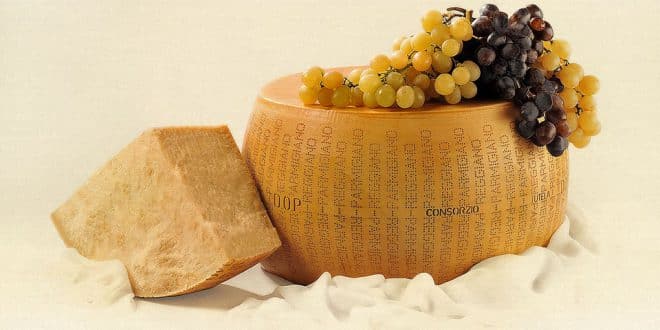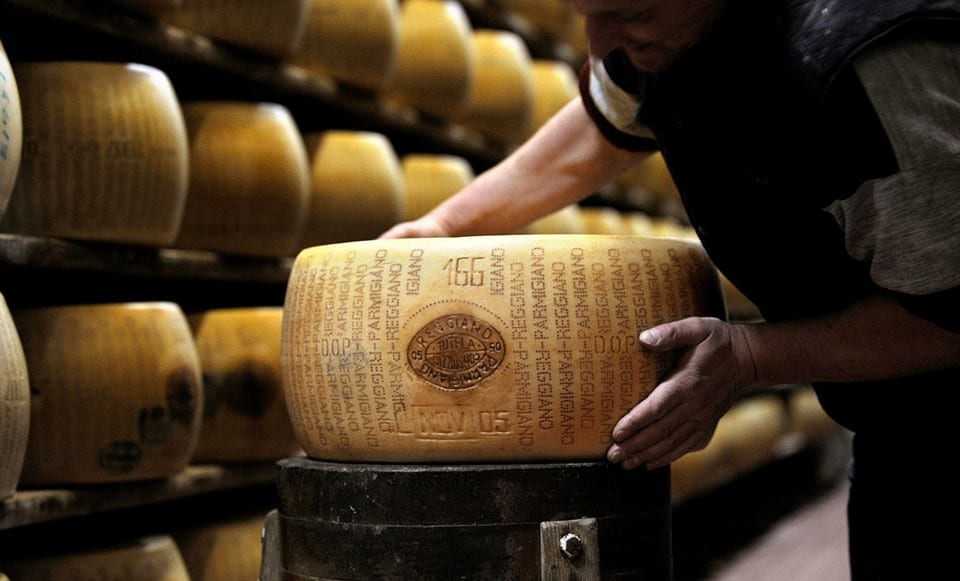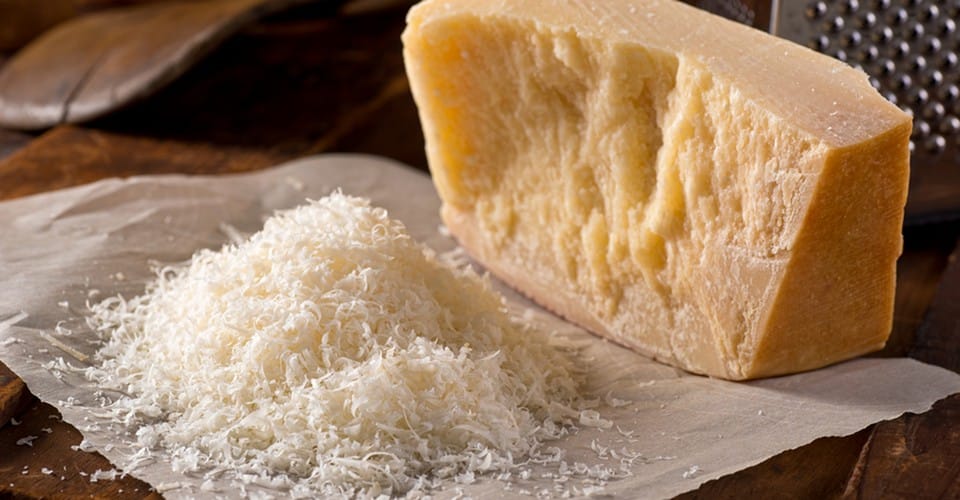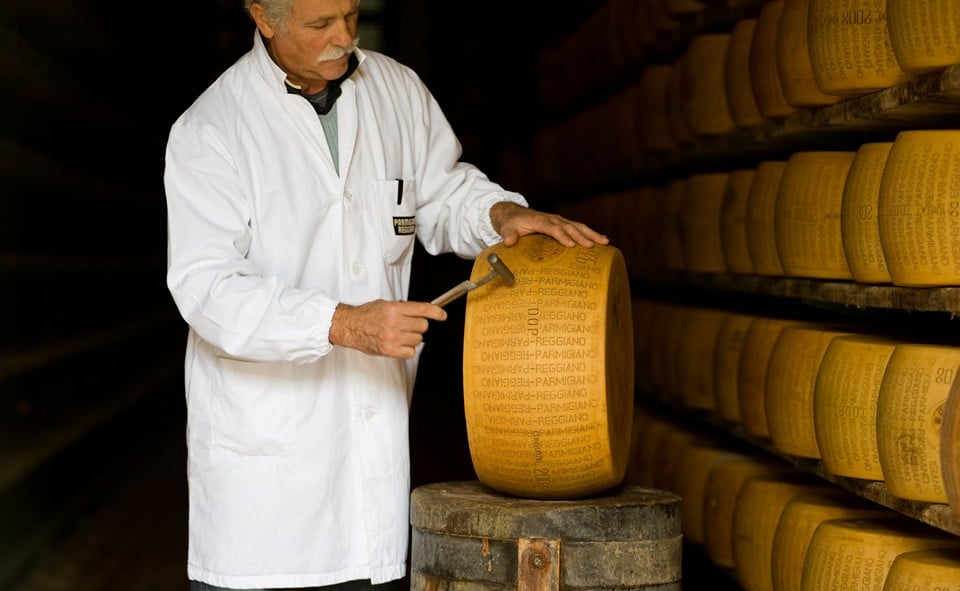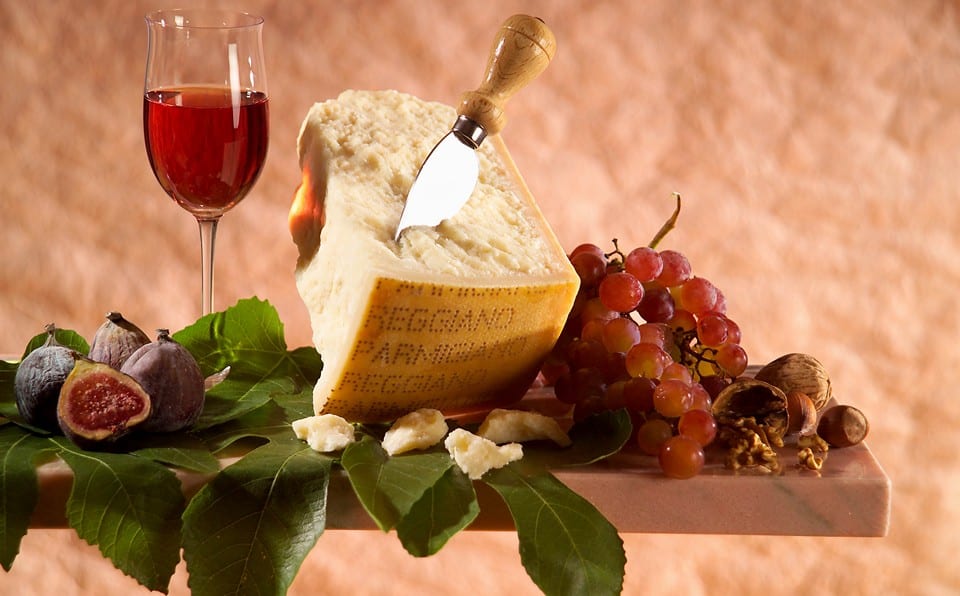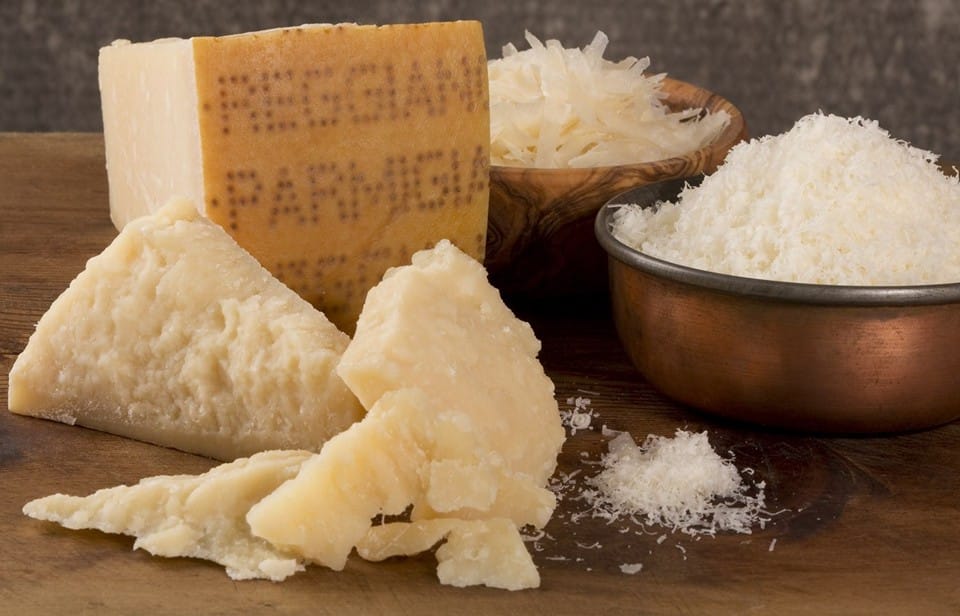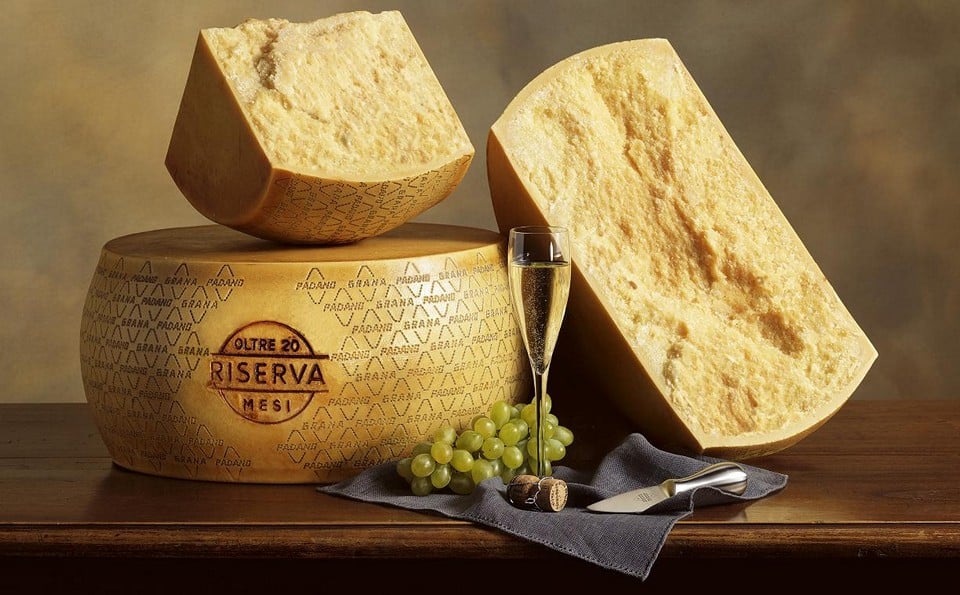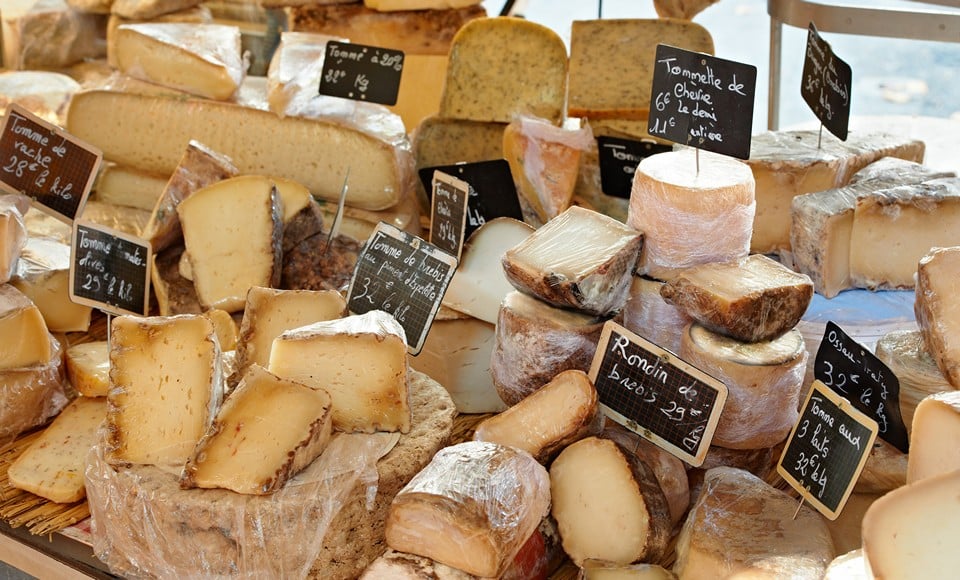Close your eyes and whisper: “Parmesan!” And now you find yourself sitting in the shade of a grapevine, sipping your favorite wine and savoring the taste of cheese. Truly a magical word! Equally enchanting is the owner of this name – Parmigiano Reggiano cheese.
We will tell you about where it was born, how it has come down to us, in which recipes it is used, its composition, and the health benefits of Parmesan. Welcome, His Majesty Parmesan!
Page Contents
History of Parmigiano Reggiano
The recipe for this cheese was developed about 900 years ago in the territory of Cistercian and Benedictine monasteries. Over all these years, the composition of Parmesan has remained unchanged: milk, water, salt, and a lion’s share of patience during the maturation process.
The monasteries were located on the plain between Parma and Reggio Emilia. It was from these provinces that the cheese derived its name, Parmigiano Reggiano. The abundance of pastures contributed to the development of farming in the monasteries and the surplus of milk, which necessitated the search for a recipe for an ideal dairy product capable of long-term storage.
The first written mention of the cheese appears in a notarial deed drawn up in Genoa in 1254, where a wealthy woman mortgaged her house for annual supplies of 25 kg of cheese produced in Parma. At that time, it was known as caseus parmensis (the Latin name).
During the 14th century, Cistercians from the Benedictine Abbey maintained a monopoly on Parmesan production and sold it throughout Italy.
In the 16th century, the recipe for Parmesan cheese was sold to Europe, where the best chefs of Germany and France began to prepare it. On August 7, 1612, the Duke of Parma compiled a list of places where the word “Parma” could be used in the name of their products to protect the original production.
By 2004, there were approximately 512 cheese producers worldwide using the name “Parmesan.” However, in 2008, the European Court ruled that only cheese made in the northern regions of Italy could be called “Parmesan.”
Historical facts and literary episodes:
- In 1344, Giovanni Boccaccio mentioned the use of “grated Parmesan for pasta and ravioli” in his book “Decameron.”
- The renowned playwright Molière, in his quest to prolong his life, followed an unusual diet consisting of 320 grams of Parmesan cheese and 3 glasses of port wine per day.
- Dr. Livesey, a character in Robert Louis Stevenson’s “Treasure Island,” said, “You’ve seen my snuff-box, haven’t you? But you’ve never seen me take snuff because I always put a piece of Parmesan cheese in my snuff-box. It’s very nourishing!”
- There is a version that credits the popularization of Parmesan in America to the third President of the United States, Thomas Jefferson.
How Parmesan is made – the manufacturing process:
Parmesan cheese is often referred to as the king of cheeses. Its production takes place every year from early April to mid-November, known as the “green pastures” period. Currently, cheese produced in only five provinces of Italy (Parma, Reggio Emilia, Modena, Padua, and Bologna) is considered authentic Parmesan, distinguished by the special quality labels DOP, DOC, or DOCG.
The milk for the cheese is obtained from cows grazing exclusively in the regions where original Parmigiano Reggiano is made.
- I recommend taking a gastronomic tour from Bologna to a Parmesan cheese production facility with a guide named Natalya Miroshnikova, an expert on the Emilia-Romagna region. Also, take a look at the photo report from the cheese factory.
To produce the cheese, they use milk from two milkings: morning and evening. The evening milk is left in vats to curdle naturally. The next morning, the fresh milk is skimmed and mixed with the already fermented milk. The mixture is then sent to copper vats, each holding 5 hundredweight, which is sufficient to produce two cheese wheels (50 kg). In other words, approximately 10 liters of milk are needed to make 1 kg of Parmesan.
After being aged at 20 degrees, the vats are heated to 34 degrees, and rennet, an enzyme that digests proteins in a calf’s stomach, is added. The resulting curd is cut into large pieces and then vigorously broken into tiny particles the size of rice grains. The vat is then heated to 55 degrees.
Until the 1950s, the heating process was done using fire, which was tended to by young workers who added firewood. This profession was called “sotcaldèra,” which literally means “under the kettle.”
Once the proper dehydrated granules have formed, the mixing and heating process is stopped, and the heavy protein particles settle at the bottom. The curd, which has settled, is transferred onto hemp cloth using a wooden paddle and then placed back into the whey.
The curd is cut into two parts and placed in round wooden molds lined with cheesecloth, which are periodically turned to remove excess whey. By the way, the collected whey is carefully gathered and used as feed for pigs, which will eventually become Prosciutto di Parma (Parma ham).
At the end of the first day, the cloth is removed, and the cheese is placed into a marking mold. Italian cheesemakers refer to the two cheese wheels obtained from one vat as twins.
On the fourth day, the cheese heads are placed in large vats filled with salty water. The mass absorbs the necessary amount of salt from it to achieve the proper taste and ensure long-term preservation (salt is the only preservative in Parmesan). Over the course of a year, the cheese matures in molds in special rooms on large wooden tables, where it is rubbed and turned every 10 days.
After being quality-checked by experts, the suitable cheese heads are transferred to storage for at least a year of final aging. The maturity of the cheese is determined by the sound it makes when struck with a silver hammer.
- Interesting fact: Italian immigrants in Argentina adapted the production conditions to local peculiarities and named the cheese Reggianito, which matures in a shorter time than Parmesan – only 5-6 months.
Application
Parmigiano Reggiano rightfully holds the title of the king of the cheese world. As the best of the best, it can be incorporated into any dish and fit perfectly. It is used in salads and soups, pizzas and risottos, pastas and lasagnas.
If you’re baking meat, sprinkle it with Parmesan. It will create a splendid crispy crust and enrich the flavor of the dish with nutty notes.
Types – What to Pair Them With?
The method of using Parmigiano depends on its age:
- Young cheese Fresco (12 to 18 months) is consumed on its own, and served as a cheese platter. It is also used as a filling for meat rolls. It pairs well with juicy fruits.
- Mature cheese Vecchio (18 to 24 months) is often used in hot dishes recipes (lasagna, pasta, sauces) for baking meat and fish. As an accompaniment to wines, it beautifully enhances the aroma of any red wine with fruity notes and reveals all its flavor secrets when paired with a light white wine. Mature Parmesan is a crucial component in cheese ice cream.
- Aged cheese Stravecchio (30 months or more) is excellent when grated over pasta and seafood dishes. It is consumed on its own, combined with figs, pears, and wine. Its rind is added to soups to give them a spicy taste.
Parmesan is most commonly available in 24-month aging, but occasionally, though very rarely, you can find specimens aged 48 or even 60 months, which can be purchased at specialized exhibitions and fairs. These cheeses have an unparalleled piquant taste and a wonderfully crumbly texture. They are used as appetizers for pasta and meat and pair exceptionally well with French and Italian red wines.
Parmesan confirms its title even further by having dessert recipes based on it.
With just 100g of cheese at hand, you can delight your loved ones with unusual cheese candies. Cut it into pieces the size of half a walnut, melt dark chocolate, and dip the Parmesan into it. Once the glaze solidifies, the candies are ready to be enjoyed. Bon appétit!
Caloric Content, Chemical Composition, and Health Benefits
Like a true king, Parmesan is a leader among its peers in terms of its content of beneficial substances. Its nutritional value is 392 kcal per 100g of the product, which contains:
- Protein 33g;
- Fat 28.4g;
- Carbohydrates 3.2g;
- Sodium chloride 1.39g;
- Calcium 1160mg;
- Other microelements (phosphorus, potassium, magnesium, zinc) 827mg;
- Vitamin A 270mcg;
- Vitamins of the B group 518.2mcg;
- Vitamin PP 55mcg;
- Pantothenic acid 320mcg;
- Biotin 40mg;
- Cholesterol 68mg.
Let’s consider the beneficial properties of the cheese based on the amount of substances it contains. Parmesan is an excellent source of protein. Just 28g of cheese per day provides one-fifth of the daily protein requirement for an individual. It is worth noting that the cheese contains all nine essential amino acids necessary for protein synthesis in the body.
As a result of its long aging process, Parmesan is easily digestible, making it an excellent choice for introducing cheese into the diet of children as young as ten months old, as well as for elderly individuals with sensitive digestion and athletes as a quick source of energy.
The calcium content in Parmesan is such that consuming 57 grams per day provides 67% of the daily recommended intake of this mineral. Additionally, the presence of vitamin D enhances calcium absorption, which is especially important for children, the elderly (for preventing osteoporosis), and postmenopausal women.
Parmesan contains a significant amount of vitamin B12, necessary for the formation of red blood cells and maintaining the nervous system, as well as vitamin A, which improves vision, the appearance of the skin, and teeth.
Parmigiano Reggiano does not contain lactose, making it ideal for individuals with milk digestion problems.
Parmesan is one of the safest cheeses. Due to its prolonged aging, it has such low moisture content that bacteria have no opportunity for growth and development.
Despite all its positive properties, it is important to remember that cheese contains sodium, which can accumulate in the body and lead to increased blood pressure. It is also relatively high in calories. Therefore, doctors recommend consuming no more than 70 grams of the product per day.
Grana Padano is a sibling of Parmesan
Grana Padano is an Italian hard cheese. Unlike Parmesan, Grana Padano is produced in 27 provinces of Italy. There is a belief that Grana Padano is a cheap substitute for Parmesan, but this is fundamentally incorrect. It is a distinct cheese with its own separate history.
What are the differences between these siblings? When producing Parmesan, specific requirements are placed on the type of diet for the cows that provide the milk. Such strict conditions are not imposed when selecting the raw material for Grana Padano.
Parmesan is made using a blend of whole and skimmed milk, while Grana Padano uses partially skimmed milk.
The minimum aging period for Parmesan is one year, while Grana Padano ages for nine months. The color of Parmesan is golden-straw, intensifying with age, while Grana Padano ranges from white to straw.
And, of course, the main difference lies in their flavors. Parmesan is piquant with a nutty aroma and hints of melted butter. Grana Padano is less sharp but saltier, with notes of dried fruit.
Grated Grana is often used as a substitute for Parmesan in culinary recipes. It is also enjoyed as an appetizer with red wine.
Parmesan Price in Italy
“How much does the king cost?” you may ask. In Italy, the price of Parmesan varies depending on its age, ranging from 12 to 30 Euros per kilogram. During fairs and festivals, you can find cheese at lower prices.
And that’s all about Parmigiano Reggiano! We have endeavored to provide you with the most comprehensive information about this cheese king. We would like you to consider Italy as you browse for your next vacation destination. Pay a visit to the king and it will stay in your heart forever. Enjoy your vacation with a flavorful touch!”
Interesting facts about Parmesan
- Parmesan, also known as Parmigiano Reggiano, is considered one of the oldest and most prestigious cheeses in the world, with a history dating back over 800 years. Its traditional production methods have remained virtually unchanged since medieval times.
- The production of Parmesan cheese is strictly regulated and can only be made in certain regions of Italy, including Parma, Reggio Emilia, Modena, Bologna, and Mantua. The unique combination of soil, climate, and specific production techniques in these areas contributes to the exceptional quality and flavor of the cheese.
- It takes approximately 550 liters of fresh cow’s milk to produce just one wheel of Parmesan cheese, which weighs around 30 kilograms. This large quantity of milk contributes to the cheese’s rich and intense flavor.
- Parmesan cheese is made using only three ingredients: cow’s milk, salt, and rennet. No additives or preservatives are used in the production process, making it a pure and natural cheese.
- Parmesan is aged for a minimum of 12 months, but some wheels are aged for up to 36 months or more. The longer the aging process, the more complex and intense the flavor becomes, with nutty and fruity notes developing over time.
- The cheese undergoes a unique maturation process during which it is carefully turned and brushed with brine to develop its distinctive hard texture and granular consistency. This process contributes to its long shelf life and enhances its flavor profile.
- Parmesan cheese is not only delicious on its own but also a versatile ingredient in various dishes. It adds depth and richness to pasta, risottos, soups, and salads and is a perfect companion for balsamic vinegar, honey, and fresh fruits.
 Italy for me From Italy with love
Italy for me From Italy with love

